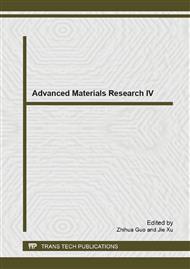[1]
H.Y. Qaswari: Cement and Concrete Research, 30, (2000), pp.739-746.
Google Scholar
[2]
T. Soshiroda, K. Voraputhaporn, Y. Nozaki: Materials and Structures, 39, (2006), p.133–142.
Google Scholar
[3]
G. Pascale, A. Di Leo, V. Bonora: (2003) J. Mater. Civ. Eng., 15(5), (2003), p.452–459.
Google Scholar
[4]
G.F. Kehder: Materials and structures, 32, (1999), pp.410-417.
Google Scholar
[5]
G. Concu, B. De Nicolo, L. Pani: Structural Survey, 29 (2), (2011), pp.147-161.
Google Scholar
[6]
A. D'Ambrisi, M.T. Cristofaro, M. De Stefano, in: Proc. of 14th World Conference on Earthquake Engineering, Beijing, China (2008).
Google Scholar
[7]
RILEM Draft Recommendation, 43-CND: Materials and structures, 26, (1993).
Google Scholar
[8]
EN 206-1. Concrete - Part 1: Specification, performance, production and conformity (2000).
Google Scholar
[9]
EN 12504-4. Testing concrete- Part 4. Determination of ultrasonic pulse velocity (2004).
Google Scholar
[10]
EN 14579. Natural stone test methods. Determination of sound speed propagation. (2004).
Google Scholar
[11]
Basic Principles of Ultrasonic Testing, NDT Resource Center. Information on http: /www. ndt-ed. org/EducationResources/CommunityCollege/Ultrasonics/cc_ut_index. htm.
Google Scholar
[12]
EN 12504-2. Testing concrete in structures. Non-destructive testing. Determination of rebound number (2001).
DOI: 10.3403/30397523
Google Scholar
[13]
EN 12390-3. Testing hardened concrete. Compressive strength of test specimens (2001).
Google Scholar
[14]
M. Lenzi, D. Versari, R. Zambrini: Indagine sperimentale di calibrazione del metodo combinato SonReb, INARCOS (2010).
Google Scholar
[15]
RILEM NDT 4: Recommendation for in situ concrete strength determination by non destructive combined methods, Compendium of RILEM Technical Recommendations, E&FN Spon, London (1993).
DOI: 10.1201/9781482271362-55
Google Scholar
[16]
A. Di Leo, G. Pascale: Il giornale delle prove non distruttive, 4, (1994).
Google Scholar
[17]
J. Gasparik, in: Quaderno didattico, AIPND, Brescia, (1992).
Google Scholar
[18]
Y. Tanigawa, K. Baba, H. Mori, in: Proc. of In Situ/Nondestructive Testing of Concrete, Detroit, American Concrete Institute, SP-82, (1984), pp.57-76.
Google Scholar


